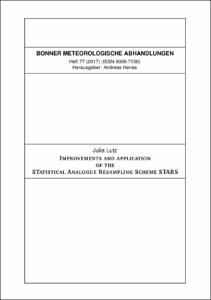Lutz, Julia: Improvements and application of the STatistical Analogue Resampling Scheme STARS. - Bonn, 2017. - Dissertation, Rheinische Friedrich-Wilhelms-Universität Bonn.
Online-Ausgabe in bonndoc: https://nbn-resolving.org/urn:nbn:de:hbz:5n-47561
Online-Ausgabe in bonndoc: https://nbn-resolving.org/urn:nbn:de:hbz:5n-47561
@phdthesis{handle:20.500.11811/7196,
urn: https://nbn-resolving.org/urn:nbn:de:hbz:5n-47561,
author = {{Julia Lutz}},
title = {Improvements and application of the STatistical Analogue Resampling Scheme STARS},
school = {Rheinische Friedrich-Wilhelms-Universität Bonn},
year = 2017,
month = jul,
volume = 77,
note = {Basically, there are two approaches to downscale climate simulations from global climate models to a regional scale: dynamical and statistical downscaling. This thesis focuses on a statistical method – the Statistical Analogue Resampling Scheme (STARS) – which rearranges observed weather data according to a prescribed linear regression of a given meteorological variable (e.g., temperature). The STARS model is analysed and further developed to provide accurate climate data for impact modelling.
First, the use of gridded data instead of station data is tested for an area covering Southern Africa. Second, the model is applied on a continental scale (the whole of Europe). Third, the climate projections of STARS for the 21st century are evaluated by comparing them to projections from a dynamical regional climate model. To this end, the STARS model is forced with past data from the same dynamical model.
The good performance of STARS in Southern Africa indicates that it is possible to use gridded data as model input. The application on a continental scale showed model deficiencies in temperature and short wave radiation. Those were corrected in a new model version. Now the model is able to provide good results on a continental scale. The forcing and comparison with dynamical model data shows good results for the first half of the 21st century, while for the middle of the century only precipitation and temperature are well reproduced. For the end of the century, it is not possible to compute simulations that fulfill the prescribed model criteria of STARS. Overall, this makes STARS an alternative to dynamical regional climate models for a time span of 40 or 50 years into the future.},
url = {https://hdl.handle.net/20.500.11811/7196}
}
urn: https://nbn-resolving.org/urn:nbn:de:hbz:5n-47561,
author = {{Julia Lutz}},
title = {Improvements and application of the STatistical Analogue Resampling Scheme STARS},
school = {Rheinische Friedrich-Wilhelms-Universität Bonn},
year = 2017,
month = jul,
volume = 77,
note = {Basically, there are two approaches to downscale climate simulations from global climate models to a regional scale: dynamical and statistical downscaling. This thesis focuses on a statistical method – the Statistical Analogue Resampling Scheme (STARS) – which rearranges observed weather data according to a prescribed linear regression of a given meteorological variable (e.g., temperature). The STARS model is analysed and further developed to provide accurate climate data for impact modelling.
First, the use of gridded data instead of station data is tested for an area covering Southern Africa. Second, the model is applied on a continental scale (the whole of Europe). Third, the climate projections of STARS for the 21st century are evaluated by comparing them to projections from a dynamical regional climate model. To this end, the STARS model is forced with past data from the same dynamical model.
The good performance of STARS in Southern Africa indicates that it is possible to use gridded data as model input. The application on a continental scale showed model deficiencies in temperature and short wave radiation. Those were corrected in a new model version. Now the model is able to provide good results on a continental scale. The forcing and comparison with dynamical model data shows good results for the first half of the 21st century, while for the middle of the century only precipitation and temperature are well reproduced. For the end of the century, it is not possible to compute simulations that fulfill the prescribed model criteria of STARS. Overall, this makes STARS an alternative to dynamical regional climate models for a time span of 40 or 50 years into the future.},
url = {https://hdl.handle.net/20.500.11811/7196}
}






